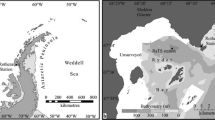Abstract
Four algae of freshwater phytoplankton were studied in monospecific culture: Chlorella vulgaris, Fragilaria crotonensis, Staurastrum pingue and Synechocystis minima. Experiments were performed to determine the growth rate over a wide range of light intensities (5–800 µE m−2 s−1, 15/9 light/dark photoperiod) and temperatures (10–35 °C). The results provide a set of parameters (particularly the maximal growth rate associated to optimal conditions of light and temperature) for a three-equation model used to described the growth rate response of a non-nutrient-limited culture.
Similar content being viewed by others
References
Ahlgren G., 1978. Growth of Oscillatoria agardhii in chemostat culture. 2. Dependance of growth constants on temperature. Mitt. Int. Ver. Limnol. 21: 88–102.
Ahlgren G., 1987. Temperature functions in biology and their application to algal growth constants. Oikos 49: 177–190.
Chen C. W. & G. T. Orlob, 1975. Ecological simulation for aquatic environments. In B. C. Patten (ed.), Systems analysis and simulations in ecology. 3, Acad. Press, N.Y.: 475–528.
Cloern J. E., 1976. Population dynamics of Cryptomonas ovata: a laboratory, field and computer simulation study. Ph. D., Washington State University, 102 p.
Dauta A., 1982a. Conditions de développement du phytoplancton. Etude comparative de huit espèces en culture. I. Détermination des paramètres de croissance en fonction de la lumière et de la température, Annls Limnol. 18: 217–262.
Dauta A., 1982b. Conditions de développement du phytoplancton. Etude comparative de huit espèces en culture. II. Rôle des nutriments: assimilation et stockage. Annls Limnol. 18: 263–292.
Dauta A., 1986. Modélisation du développement du phytoplancton dans une rivière canalisée eutrophe: le Lot (France). Annls Limnol. 21: 199–132.
Di Toro D. M., D. J. O'Connor & R. V. Thomann, 1971. A dynamic model of phytoplankton populations in the Sacramento-San Joaquim delta. In R. F. Gould (ed.), Non equilibrium systems in natural water chemistry, Advances in Chemistry, Ser. 106, Am. Chem. Soc., Washington: 131–180.
Feuillade J. B. & M. Feuillade, 1987. Modelling steady-state growth and photosynthesis rates of Oscillatoria rubescens continuous cultures in relation to temperature and irradiance. J. Plankton Res. 9: 445–457.
Foy R. H., C. E. Gibson & R. V. Smith, 1976. The influence of daylength, light intensity and temperature on the growth rates of planktonic blue-green algae. Br. Phycol. J. 11: 151–163.
Goldman J. C., 1979. Physiological processes, nutrient availability, and the concept of relative growth rate in marine phytoplankton ecology. In P. G. Falkowski (ed.), Primary productivity in the sea, New-York, Plenum: 179–194.
Guerri M. M., Dauta A. & Brunel L., 1981. Interaction de la lumière et de la température sur le taux de croissance de Scenedesmus crassus. Annls Limnol. 17: 97–104.
Harris G. P., 1978. Photosynthesis, productivity and growth: the physiological ecology of phytoplankton. Ergebn. Limnol. 10: 1–163.
Hartig J. H. & D. G. Wallen, 1986. The influence of light and temperature on growth and photosynthesis of Fragilaria crotonensis Kitton. J. Freshwat. Ecol. 3: 371–382.
Jones L. W. & B. Kok, 1966. Photoinhibition of chloroplasts reactions. I. Kinetics and action spectra. Plant Physiol. 41: 1037–1043.
Konopka A. E. & T. D. Brock., 1978. Effect of temperature on blue-green algae (Cyanobacteria) in lake Mendota. Appl. Envir. Microbiol. 36: 572–576.
Lehman J. T., D. B. Botkin & G. E. Likens, 1975. The assumptions and rationales of a computer model of phytoplankton population dynamics. Limnol. Oceanogr. 20: 343–364.
Morgan K. C. & J. Kalff., 1979. Effect of light and temperature interactions on growth of Cryptomonas erosa (Cryptophyceae). J. Phycol. 15: 127–134.
Peeters J. C. & P. Eilers, 1978. The relationship between light intensity and photosynthesis: a simple mathematical model. Hydrobiol. Bull. 12: 134–136.
Post A. F., R. de Witt & L. R. Mur, 1985. Interactions between temperature and light intensity on growth and photosynthesis of the cyanobacterium Oscillatoria agardhii. J. Plankton Res. 7: 487–495.
Reynolds C. S., 1984. The ecology of freshwater phytoplankton, Cambridge University Press, London, 384 p.
Reynolds C. S., 1988. The concept of biological succession applied to seasonal periodicity of freshwater phytoplankton. Verh. Int. Ver. Limnol. 23: 683–691.
Reynolds C. S., 1989. Physical determinants of phytoplankton succession. In U. Sommer (ed.), Plankton Ecology. Springer Verlag. Berlin: 9–56.
Satoh K., 1970. Mechanism of photoinactivation in photosynthetic systems. I. The dark reaction in photoinactivation. PI. Cell Physiol., Tokyo 11: 15–27.
Sommers U., 1989. The role of competition for resources in phytoplankton succession. In U. Sommer (ed.), Plankton Ecology. Springer Verlag, Berlin: 57–106.
Steele J. H., 1962. Environmental control of photosynthesis in the sea. Limnol. Oceanogr. 7: 137–150.
Straskraba M. & M. Dvorakova, 1980. Application to the continuous culture concepts to mathematical modeling of natural phytoplankton populations. Continuous Cultivation of Microorganisms, Proc. 7th Symp. Prague, 1978: 409–416.
Tamya H., T. Iwamura, K. Shibata, E. Hase & T. Nihei, 1953. Correlation between photosynthesis and light independant metabolism in the growth of Chlorella. Biochim. Biophys. Acta 12: 24–40.
Thomann R. V., D. M. Di Toro, D. R. P. Winfield & D. J. O'Connor, 1975. Mathematical modelling of phytoplankton in lake Ontario. I-Model development and verification. U.S. Envir. Prot. Agency, Corvallis, Oregon, 176 p.
Zevenboom W., 1980. Growth and nutrient uptake kinetics of Oscillatoria agardhii. A comparative investigation of continuous cultures and natural populations of a cyanobacterium. Ph. D., Univ. Amsterdam, 178 p.
Author information
Authors and Affiliations
Rights and permissions
About this article
Cite this article
Dauta, A., Devaux, J., Piquemal, F. et al. Growth rate of four freshwater algae in relation to light and temperature. Hydrobiologia 207, 221–226 (1990). https://doi.org/10.1007/BF00041459
Received:
Revised:
Accepted:
Issue Date:
DOI: https://doi.org/10.1007/BF00041459




